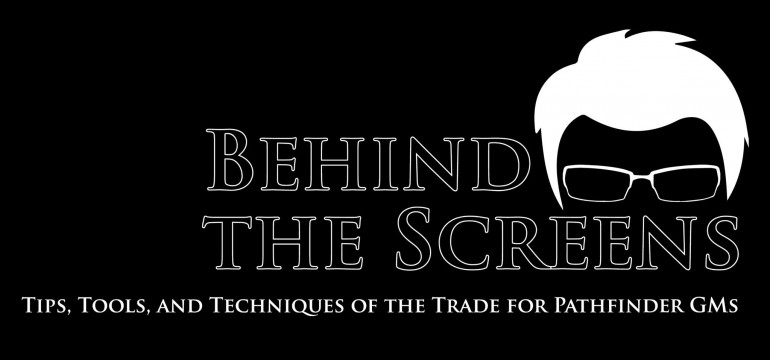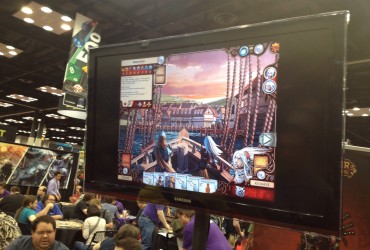Are you a new GM or a veteran looking for ways to improve your GMing skills? Take a peek Behind the Screens, a twice-monthly advice column dedicated to making you a better GM. A seasoned gamer and GM, Anthony Li offers his thoughts on all sorts of GM related topics as well as in-depth reviews of published adventures by Paizo and other 3rd Party Publishers.
This week I thought we’d have a discussion about one of the more common ways that I breakdown an adventure. As a GM, understanding the parts of an adventure and how they fit together can be incredibly helpful in the event that your players decide that to run off track. And let’s face it. If you GM long enough, your players will end up doing something you’re not prepared for. In this article, I aim to give you a foundational understanding of adventure stories so that you might use that knowledge to better adapt to your players’ hijinks.
Literary analysis is one of the more valuable techniques that you, as a GM, can acquire. An RPG adventure is just a story after all and being able to evaluate it with a literary eye is like being able to see the code in the Matrix. The elements of an adventure become yours to control, to rearrange and modify as you will. So what are you looking out for? Generally, there are five important elements of narrative story telling that I typically try and identify in an adventure.
First is the inciting incident. This is the event that got the proverbial ball rolling. Something that kicked off the events that led to the adventure’s primary conflict. This doesn’t necessarily need to involve the PCs at all. Indeed, in most of the published adventures I’ve read the inciting incident is buried deep in the adventure background. To offer you a concrete example, let’s say the small village of Backwater hasn’t paid its annual tribute to the vicious warlord that claims dominion over it. The warlord knows this and plans to make Backwater’s citizens pay up or suffer the consequences!
Next is the call to action. Here’s where your PCs come in. This is basically your adventure hook. Here is where your players are drawn into the adventure and motivated to go and do something proactive. The warlord sends thugs to go and rough up some of Backwater’s more prominent citizens. Maybe these are people that your PCs care about. They might even be the PCs themselves. Or maybe the PCs just happen to get caught in the middle of it. If the call to action is successful, your players should be motivated to help Backwater out.
After your PCs have been properly motivated we progress to the next element, tension building, otherwise known as rising action for you literary buffs. This is the point in the adventure where the PCs try and go after the objective but face challenges along the way. Tension building is rarely ever a single event but rather a series of events over the course of the adventure. A lot can happen here and it will vary greatly from adventure to adventure with the ultimate goal being a buildup of tension and excitement. Going back to our example, let’s say the PCs have journeyed to the warlord’s fortress, kicked down the door, and charge into his personal chambers ready to throw down. Only they discover that the warlord has already left and is on a campaign of terror, first stop: Backwater.
Then we come to everyone’s favorite narrative beat, the climax. This is the story’s high point, the main confrontation. For most published adventures this section may as well read, “Insert Boss Fight Here”. So the band of heroes in our example race back to Backwater and stop the warlord from sacking the village. There’s a massive confrontation. Swords are swung, spells are slung, and after an epic struggle the PCs triumph.
Finally we have the resolution. This could take several forms depending on the type of story you’re telling. If you’re running a clear-cut pulp style adventure in the tradition of Robert E. Howard’s Conan the Barbarian then once the warlord is defeated and the village is saved the PCs can bask in the fame and glory that is so justly deserved. But if you’re running dark and gritty fantasy like Glenn Cook’s the Black Company then perhaps the defeat of the warlord has left a power vacuum allowing a bigger badder eviler guy to step onto the scene.
Whatever the case, the resolution should serve two main purposes. First it allows the PCs to tie up any loose ends and give them a chance to do something that isn’t action-packed and adrenaline fueled. Second, resolution scenes give a GM a great chance to seed hooks into the next series of adventures. Many published adventures gloss over this bit because how you wrap up your games at home is mostly your own business. But it’s important to remember to allow your players some downtime between adventures. Resolution and downtime periods serve as a critical contrast to action packed, high tension encounters and keeps things from becoming bland.
So there you have it. A brief synopsis of literary analysis as applied to an RPG adventure. This certainly isn’t the only way to approach adventure design/preparation. A couple of notable alternatives are the Monomyth, a more high-concept approach to storytelling put forth by American mythologist Joseph Campbell and the 5 Room Dungeon a modular style of dungeon design that can easily be adapted to adventure analysis. Many more words have been written by many other writers on these topics. So I’ll leave you to investigate them for yourselves if you’re interested. You can find more about the Monomyth here and about the 5 Room Dungeon here.
As always feel free to leave questions in the comments section below!







Dan Harmon’s Story Circle (a simplified version of Campbell’s Monomyth) is another great resource. You can get started with it here:
http://channel101.wikia.com/wiki/Story_Structure_101:_Super_Basic_Shit